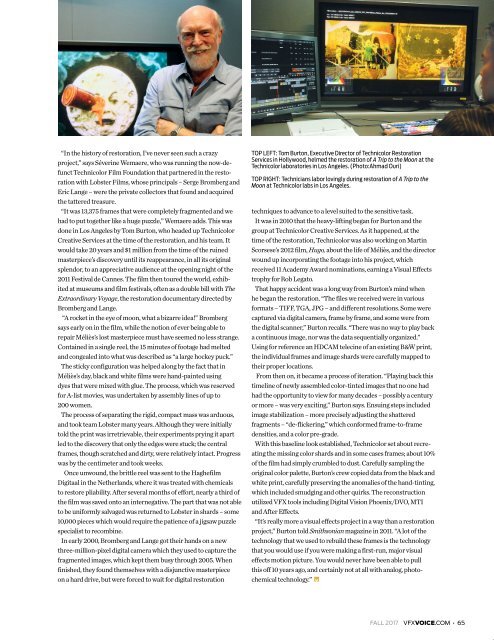You also want an ePaper? Increase the reach of your titles
YUMPU automatically turns print PDFs into web optimized ePapers that Google loves.
“In the history of restoration, I’ve never seen such a crazy<br />
project,” says Séverine Wemaere, who was running the now-defunct<br />
Technicolor Film Foundation that partnered in the restoration<br />
with Lobster Films, whose principals – Serge Bromberg and<br />
Eric Lange – were the private collectors that found and acquired<br />
the tattered treasure.<br />
“It was 13,375 frames that were completely fragmented and we<br />
had to put together like a huge puzzle,” Wemaere adds. This was<br />
done in Los Angeles by Tom Burton, who headed up Technicolor<br />
Creative Services at the time of the restoration, and his team. It<br />
would take 20 years and $1 million from the time of the ruined<br />
masterpiece’s discovery until its reappearance, in all its original<br />
splendor, to an appreciative audience at the opening night of the<br />
2011 Festival de Cannes. The film then toured the world, exhibited<br />
at museums and film festivals, often as a double bill with The<br />
Extraordinary Voyage, the restoration documentary directed by<br />
Bromberg and Lange.<br />
“A rocket in the eye of moon, what a bizarre idea!” Bromberg<br />
says early on in the film, while the notion of ever being able to<br />
repair Méliès’s lost masterpiece must have seemed no less strange.<br />
Contained in a single reel, the 15 minutes of footage had melted<br />
and congealed into what was described as “a large hockey puck.”<br />
The sticky configuration was helped along by the fact that in<br />
Méliès’s day, black and white films were hand-painted using<br />
dyes that were mixed with glue. The process, which was reserved<br />
for A-list movies, was undertaken by assembly lines of up to<br />
200 women.<br />
The process of separating the rigid, compact mass was arduous,<br />
and took team Lobster many years. Although they were initially<br />
told the print was irretrievable, their experiments prying it apart<br />
led to the discovery that only the edges were stuck; the central<br />
frames, though scratched and dirty, were relatively intact. Progress<br />
was by the centimeter and took weeks.<br />
Once unwound, the brittle reel was sent to the Haghefilm<br />
Digitaal in the Netherlands, where it was treated with chemicals<br />
to restore pliability. After several months of effort, nearly a third of<br />
the film was saved onto an internegative. The part that was not able<br />
to be uniformly salvaged was returned to Lobster in shards – some<br />
10,000 pieces which would require the patience of a jigsaw puzzle<br />
specialist to recombine.<br />
In early 2000, Bromberg and Lange got their hands on a new<br />
three-million-pixel digital camera which they used to capture the<br />
fragmented images, which kept them busy through 2005. When<br />
finished, they found themselves with a disjunctive masterpiece<br />
on a hard drive, but were forced to wait for digital restoration<br />
TOP LEFT: Tom Burton, Executive Director of Technicolor Restoration<br />
Services in Hollywood, helmed the restoration of A Trip to the Moon at the<br />
Technicolor laboratories in Los Angeles. (Photo:Ahmad Ouri)<br />
TOP RIGHT: Technicians labor lovingly during restoration of A Trip to the<br />
Moon at Technicolor labs in Los Angeles.<br />
techniques to advance to a level suited to the sensitive task.<br />
It was in 2010 that the heavy-lifting began for Burton and the<br />
group at Technicolor Creative Services. As it happened, at the<br />
time of the restoration, Technicolor was also working on Martin<br />
Scorsese’s 2012 film, Hugo, about the life of Méliès, and the director<br />
wound up incorporating the footage into his project, which<br />
received 11 Academy Award nominations, earning a Visual Effects<br />
trophy for Rob Legato.<br />
That happy accident was a long way from Burton’s mind when<br />
he began the restoration. “The files we received were in various<br />
formats – TIFF, TGA, JPG – and different resolutions. Some were<br />
captured via digital camera, frame by frame, and some were from<br />
the digital scanner,” Burton recalls. “There was no way to play back<br />
a continuous image, nor was the data sequentially organized.”<br />
Using for reference an HDCAM telecine of an existing B&W print,<br />
the individual frames and image shards were carefully mapped to<br />
their proper locations.<br />
From then on, it became a process of iteration. “Playing back this<br />
timeline of newly assembled color-tinted images that no one had<br />
had the opportunity to view for many decades – possibly a century<br />
or more – was very exciting,” Burton says. Ensuing steps included<br />
image stabilization – more precisely adjusting the shattered<br />
fragments – “de-flickering,” which conformed frame-to-frame<br />
densities, and a color pre-grade.<br />
With this baseline look established, Technicolor set about recreating<br />
the missing color shards and in some cases frames; about 10%<br />
of the film had simply crumbled to dust. Carefully sampling the<br />
original color palette, Burton’s crew copied data from the black and<br />
white print, carefully preserving the anomalies of the hand-tinting,<br />
which included smudging and other quirks. The reconstruction<br />
utilized <strong>VFX</strong> tools including Digital Vision Phoenix/DVO, MTI<br />
and After Effects.<br />
“It’s really more a visual effects project in a way than a restoration<br />
project,” Burton told Smithsonian magazine in 2011. “A lot of the<br />
technology that we used to rebuild these frames is the technology<br />
that you would use if you were making a first-run, major visual<br />
effects motion picture. You would never have been able to pull<br />
this off 10 years ago, and certainly not at all with analog, photochemical<br />
technology.”<br />
FALL <strong>2017</strong> <strong>VFX</strong>VOICE.COM • 65




